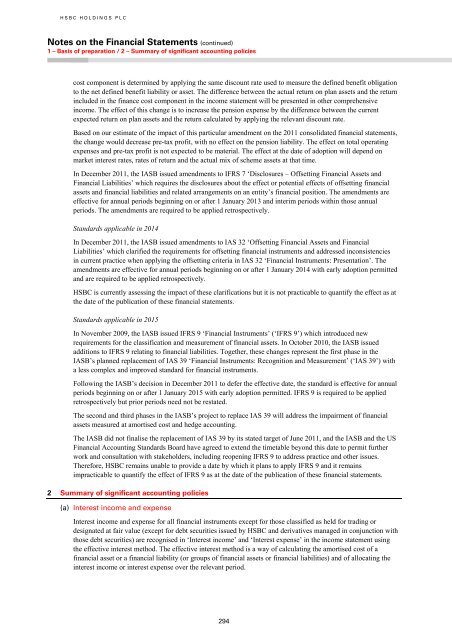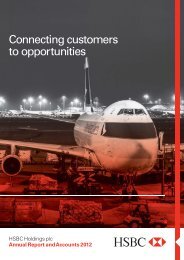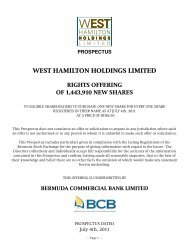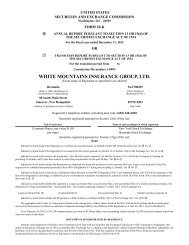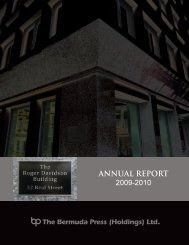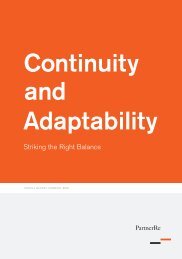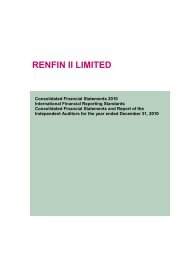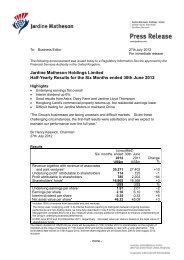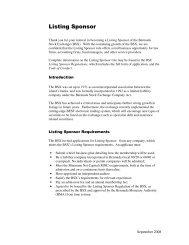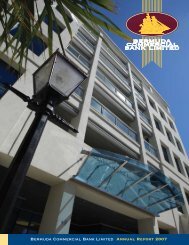- Page 1 and 2:
Connecting customers to opportuniti
- Page 3 and 4:
Who we are and what we do HSBC is o
- Page 5 and 6:
Performance ratios Credit coverage
- Page 7 and 8:
to US$27.2 billion, making HSBC the
- Page 9 and 10:
Group Chief Executive’s Business
- Page 11 and 12:
esponsibility, improve decision mak
- Page 13 and 14:
Geographical regions The geographic
- Page 15 and 16:
Top and emerging risks We classify
- Page 17 and 18:
Growth - continue to position ourse
- Page 19 and 20:
• the gain of US$83m on the sale
- Page 21 and 22:
partly offset by lower loan impairm
- Page 23 and 24:
GB&M, as well as strong mortgage le
- Page 25 and 26:
Net trading income 2011 US$m 2010 U
- Page 27 and 28:
in comparison with smaller favourab
- Page 29 and 30:
compared with 2010 were driven by a
- Page 31 and 32:
we continued to manage down unsecur
- Page 33 and 34:
Share of profit in associates and j
- Page 35 and 36:
Movement in 2011 Total reported ass
- Page 37 and 38:
Reconciliation of reported and unde
- Page 39 and 40:
Economic profit/(loss) Our internal
- Page 41 and 42:
statistical analysis of actual defa
- Page 43 and 44:
Deciding whether an available-for-s
- Page 45 and 46:
Global businesses Summary .........
- Page 47 and 48:
Global Banking and Markets GB&M pro
- Page 49 and 50:
• Loan impairment charges and oth
- Page 51 and 52:
Review of performance • CMB repor
- Page 53 and 54:
Global Banking and Markets GB&M is
- Page 55 and 56:
eduction was driven by higher alloc
- Page 57 and 58:
Strategic imperatives Expand in fas
- Page 59 and 60:
Analysis by global business HSBC pr
- Page 61 and 62:
Geographical regions Page Summary .
- Page 63 and 64:
Profit/(loss) before tax by country
- Page 65 and 66:
lower adverse foreign exchange move
- Page 67 and 68:
Retail Banking and Wealth Managemen
- Page 69 and 70:
Profit/(loss) before tax by global
- Page 71 and 72:
Profit/(loss) before tax and balanc
- Page 73 and 74:
Rest of Asia-Pacific We offer a ful
- Page 75 and 76:
The growth in profitability in the
- Page 77 and 78:
Profit before tax and balance sheet
- Page 79 and 80:
Middle East and North Africa The ne
- Page 81 and 82:
Greater collaboration between CMB a
- Page 83 and 84:
Retail Banking and Wealth Managemen
- Page 85 and 86:
Profit/(loss) before tax by country
- Page 87 and 88:
Gains less losses from financial in
- Page 89 and 90:
Retail Banking and Wealth Managemen
- Page 91 and 92:
Latin America Our operations in Lat
- Page 93 and 94:
product launches, while higher over
- Page 95 and 96:
Retail Banking and Wealth Managemen
- Page 97 and 98:
Accounting for deferred bonus arran
- Page 99 and 100:
49 Assets by geographical region an
- Page 101 and 102:
Capital and liquidity Preserving ou
- Page 103 and 104:
atio after an observation and revie
- Page 105 and 106:
Potential impact on HSBC • Intern
- Page 107 and 108:
On a constant currency basis, our p
- Page 109 and 110:
Maximum exposure to credit risk (Au
- Page 111 and 112:
Gross loans and advances by industr
- Page 113 and 114:
Loans and advances to banks by geog
- Page 115 and 116:
officials. This process enabled us
- Page 117 and 118:
experienced positive growth during
- Page 119 and 120:
Exposures to peripheral eurozone co
- Page 121 and 122:
We expect low growth to continue in
- Page 123 and 124:
Exposures to countries in the euroz
- Page 125 and 126:
average LTV ratios for new business
- Page 127 and 128:
property and additional loan impair
- Page 129 and 130:
with central banks considered stron
- Page 131 and 132:
Past due but not impaired loans and
- Page 133 and 134:
minimum and reduce capital repaymen
- Page 135 and 136:
Corporate and Commercial forbearanc
- Page 137 and 138:
Impairment allowances (Audited) The
- Page 139 and 140:
Movement in impairment allowances b
- Page 141 and 142:
2010 Europe Hong Kong Rest of Asia-
- Page 143 and 144:
Net loan impairment charge to the i
- Page 145 and 146:
customers in Greece. New collective
- Page 147 and 148:
The above table shows residential m
- Page 149 and 150:
any impairment allowances recognise
- Page 151 and 152:
The credit quality of the loans and
- Page 153 and 154:
impairment charges in one SPE, Maza
- Page 155 and 156:
Designated at fair value through pr
- Page 157 and 158:
Market prices are generally not rea
- Page 159 and 160:
Liquidity and funding (Audited) Liq
- Page 161 and 162:
Cash flows payable in respect of cu
- Page 163 and 164:
Diversity of funding sources (Audit
- Page 165 and 166:
Market risk (Audited) Market risk i
- Page 167 and 168:
Trading portfolios (Audited) VAR by
- Page 169 and 170:
Sensitivity of reported reserves to
- Page 171 and 172:
Repricing gap analysis of HSBC Hold
- Page 173 and 174:
Risk management of insurance operat
- Page 175 and 176:
Total net written insurance premium
- Page 177 and 178:
Europe Hong Kong Rest of Asia- Paci
- Page 179 and 180:
The following table illustrates the
- Page 181 and 182:
Neither past due nor impaired Stron
- Page 183 and 184:
Liabilities under investment contra
- Page 185 and 186:
The cost of claims is a risk associ
- Page 187 and 188:
Footnotes to Risk Credit risk 1 Inc
- Page 189 and 190:
62 The total VAR is non-additive ac
- Page 191 and 192:
Credit risk Credit risk management
- Page 193 and 194:
Credit quality of financial instrum
- Page 195 and 196:
performance over a period of time o
- Page 197 and 198:
Categories of ABSs and CDOs Definit
- Page 199 and 200:
The management of liquidity risk (A
- Page 201 and 202:
We employ a range of tools to monit
- Page 203 and 204:
Structural foreign exchange exposur
- Page 205 and 206:
assessments are input and maintaine
- Page 207 and 208:
The cost of claims and benefits can
- Page 209 and 210:
How market risk is managed All our
- Page 211 and 212:
series of stress scenarios designed
- Page 213 and 214:
Capital Capital overview ..........
- Page 215 and 216:
Regulation, removing national discr
- Page 217 and 218:
Appendix to Capital Capital managem
- Page 219 and 220:
completing the satisfactory settlem
- Page 221 and 222:
Current appointments include: Group
- Page 223 and 224:
Former appointments include: Chairm
- Page 225 and 226:
Former appointments include: Managi
- Page 227 and 228:
Board of Directors The purpose of H
- Page 229 and 230:
the non-executive Directors, partic
- Page 231 and 232:
okers, analysts’ forecasts, infor
- Page 233 and 234:
to the Board on matters relating to
- Page 235 and 236:
of KPMG and an annual report is rec
- Page 237 and 238:
Our risk appetite framework is unde
- Page 239 and 240:
of the Committee and other senior f
- Page 241 and 242:
experience of the current Directors
- Page 243 and 244:
management of the significant risks
- Page 245 and 246: oversight of internal controls over
- Page 247 and 248: Remuneration policy The quality and
- Page 249 and 250: HSBC Private Bank France HSBC Priva
- Page 251 and 252: Appendix to Report of the Directors
- Page 253 and 254: Sterling Preference Shares The Ster
- Page 255 and 256: No Directors held any short positio
- Page 257 and 258: • JPMorgan Chase & Co. gave notic
- Page 259 and 260: As part of the HSBC Share Plan 2011
- Page 261 and 262: Clawback In order to reward genuine
- Page 263 and 264: The same deliberations and assessme
- Page 265 and 266: 2011 long-term scorecard and perfor
- Page 267 and 268: 2011 executive Directors’ emolume
- Page 269 and 270: EPS growth in year 3 over the base
- Page 271 and 272: Fees Non-executive Directors’ fee
- Page 273 and 274: Pensions (Audited) V H C Cheng reti
- Page 275 and 276: Awards of Restricted Shares HSBC Sh
- Page 277 and 278: HSBC HOLDINGS PLC Statement of Dire
- Page 279 and 280: Matters on which we are required to
- Page 281 and 282: Consolidated income statement for t
- Page 283 and 284: Consolidated balance sheet at 31 De
- Page 285 and 286: Consolidated statement of changes i
- Page 287 and 288: Called up share capital US$m 2009 O
- Page 289 and 290: HSBC Holdings statement of cash flo
- Page 291 and 292: 2010 Other reserves Called up share
- Page 293 and 294: HSBC HOLDINGS PLC Notes on the Fina
- Page 295: The consolidated financial statemen
- Page 299 and 300: Financial assets which have been re
- Page 301 and 302: − estimate the amount of loans th
- Page 303 and 304: in other comprehensive income. Thes
- Page 305 and 306: (k) Sale and repurchase agreements
- Page 307 and 308: not alter the cash flows expected a
- Page 309 and 310: Property, plant and equipment is su
- Page 311 and 312: is recognised in addition to the ex
- Page 313 and 314: A liability adequacy test is carrie
- Page 315 and 316: 3 Net income/(expense) from financi
- Page 317 and 318: Non-life insurance Life insurance (
- Page 319 and 320: Net assets/(liabilities) recognised
- Page 321 and 322: company (although in practice this
- Page 323 and 324: Defined benefit pension plans Net a
- Page 325 and 326: Post-employment defined benefit pla
- Page 327 and 328: The effect of changes in the discou
- Page 329 and 330: 9 Share-based payments Income state
- Page 331 and 332: Significant weighted average assump
- Page 333 and 334: Tax reconciliation The tax charged
- Page 335 and 336: US Of the total net deferred tax as
- Page 337 and 338: Quarterly coupons on capital securi
- Page 339 and 340: Profit/(loss) for the year 2011 Eur
- Page 341 and 342: Other information about the profit/
- Page 343 and 344: Other financial information Net ope
- Page 345 and 346: Held for trading US$m Designated at
- Page 347 and 348:
15 Trading assets 2011 2010 US$m US
- Page 349 and 350:
For all financial instruments where
- Page 351 and 352:
Global Banking and Markets fair val
- Page 353 and 354:
• differing loss assumptions in s
- Page 355 and 356:
Movement in Level 3 financial instr
- Page 357 and 358:
Reflected in other Reflected in pro
- Page 359 and 360:
17 Fair values of financial instrum
- Page 361 and 362:
Financial investments The fair valu
- Page 363 and 364:
Securities designated at fair value
- Page 365 and 366:
instruments designated at fair valu
- Page 367 and 368:
defaults. The aggregate principal b
- Page 369 and 370:
Financial investments listed on a r
- Page 371 and 372:
derivative transactions with the se
- Page 373 and 374:
Summarised aggregate financial info
- Page 375 and 376:
Key assumptions in VIU calculation
- Page 377 and 378:
Other intangible assets Movement of
- Page 379 and 380:
Leasehold land and buildings 2011 2
- Page 381 and 382:
Details of all HSBC subsidiaries wi
- Page 383 and 384:
28 Trading liabilities 2011 US$m 20
- Page 385 and 386:
31 Liabilities of disposal groups h
- Page 387 and 388:
Life insurance liabilities to polic
- Page 389 and 390:
34 Subordinated liabilities HSBC 20
- Page 391 and 392:
Step-up perpetual preferred securit
- Page 393 and 394:
35 Maturity analysis of assets and
- Page 395 and 396:
The financial assets above represen
- Page 397 and 398:
Other equity instruments On 9 April
- Page 399 and 400:
HSBC Bank Bermuda plans Upon the ac
- Page 401 and 402:
41 Contingent liabilities, contract
- Page 403 and 404:
Operating lease commitments At 31 D
- Page 405 and 406:
Consolidated SPEs Unconsolidated SP
- Page 407 and 408:
incorporating in the SPE transactio
- Page 409 and 410:
grounds that the trustee lacks stan
- Page 411 and 412:
criminal fines and other sanctions
- Page 413 and 414:
Shareholdings, options and other se
- Page 415 and 416:
46 Events after the balance sheet d
- Page 417 and 418:
Shareholder profile At 31 December
- Page 419 and 420:
Electronic communications Sharehold
- Page 421 and 422:
Taxation of shares and dividends Ta
- Page 423 and 424:
paid, be subject to UK inheritance
- Page 425 and 426:
Glossary Abbreviation Brief descrip
- Page 427 and 428:
Abbreviation R RBWM Repo Restricted
- Page 429 and 430:
Term Conduits Constant net asset va
- Page 431 and 432:
Term IRB foundation approach ISDA I
- Page 433 and 434:
Term Short sale Single-issuer liqui
- Page 435 and 436:
E Earnings per share 2, 15, 18, 335
- Page 437 and 438:
for directors 271 risk 184 Performa
- Page 439 and 440:
© Copyright HSBC Holdings plc 2012


